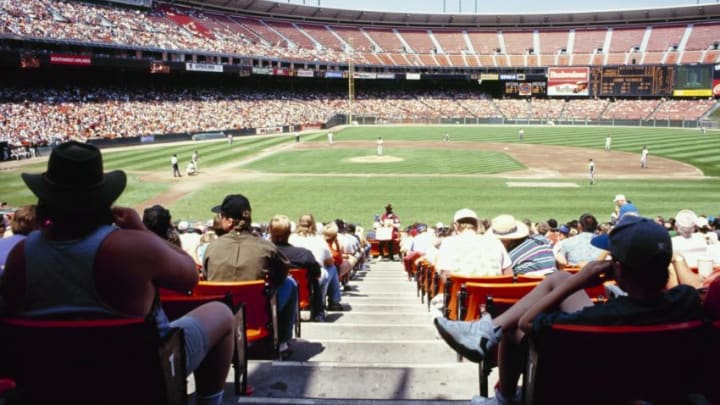At the end of the 1992 season, it appeared that the San Francisco Giants were going to leave San Francisco for Tampa Bay, and that is why 1992 was the second-worst season for the Giants in San Francisco.
In the aftermath of the Loma Prieta Earthquake during the 1989 World Series, the voters in San Francisco voted down a measure that would’ve given the Giants a new ballpark in China Basin. It was the second ballot measure for a new ballpark to fail in San Francisco. It was the second ballpark measure to fail in San Francisco in over two years. The other ballpark measure in Santa Clara failed in 1990. Thus, the Giants were still stuck at Candlestick Park for the foreseeable future.
As for the team on the field, they contended with an 85-77 record in 1990, but they finished at a disappointing 75-87 in 1991. The “Humm Baby” Era was nearing the end, as Roger Craig entered his seventh full season as manager. MVP left-fielder Kevin Mitchell had been traded to the Seattle Mariners, and two youngsters; outfielder Darren Lewis and catcher Kurt Manwaring became everyday players.
Want your voice heard? Join the Around The Foghorn team!
The Giants still had three of its core players from the late 1980s in the lineup in Will Clark, Robby Thompson and Matt Williams at first, second and third base. The team got off to a very good start in 1992, as Clark and former Cardinal MVP Willie McGee got off to fast starts. After a 6-2 win over the Chicago Cubs at Wrigley Field on May 27, the Giants were 26-18 and a game and a half up in first place in the National League West.
However, the Giants began to tumble very quickly. They went 8-22 in their next 30 games. They fell to 34-40 and were 10 games back in the West. The team remained on the outskirts of contention, as they went 16-12 in July, but after they lost seven of their first eight games in August, they were 15 games back and going nowhere.
The focus then turned to matters off the field. Another ballpark measure, this time in San Jose, had just failed, and owner Bob Lurie, who bought the Giants to prevent them from moving to Toronto in 1976, was out of options. Commissioner Fay Vincent, who didn’t generally like the idea of teams moving, made it clear that he wanted the Giants out of Candlestick Park and that Lurie had to get them out of there however he could.
Then, it happened. On Aug. 7, Bob Lurie agreed to sell the Giants to a group in Tampa Bay, who would relocate the Giants to St. Petersburg, Florida in 1993. The city of San Francisco was stunned. Just like that, baseball in San Francisco would last just two more months. This came just under three years after the Giants had gone to the World Series to play their Bay Area counterparts in the first Bay Bridge Series. That wasn’t the only rivalry that was going to die, however.
More importantly, their historic rivalry with the Dodgers, which had dated back exactly 100 years, was going to die. It was Upper Manhattan against Brooklyn, The Polo Grounds against Ebbets Field and Coogan’s Bluff against Flatbush. The two teams then brought baseball to the West Coast together in 1958, and it was San Francisco against Los Angeles. Suddenly, it was going to be Los Angeles against Tampa Bay. The rivalry was really going to be no more.
More from Around the Foghorn
- Atlanta claims SF Giants C Chadwick Tromp off waivers
- SF Giants: Could Johnny Cueto help down the stretch?
- SF Giants: Does Thairo Estrada have a role in 2022?
- SF Giants activate Alex Wood, option Sammy Long, and DFA Chadwick Tromp
- SF Giants: Hard-throwing reliever could be key in playoffs
Mayor Frank Jordan vowed to everything he could to keep the Giants in San Francisco and begged the league to wait for investors from San Francisco to make an offer. However, things continued to look bleak, and on Sept. 27, 45,630 fans came to The Stick for what most of them believed would be the final game the Giants would ever play in San Francisco.
It was a very somber 88-degree day at The Stick, as the Giants took on the Cincinnati Reds, and many heartbroken fans cried and begged their beloved team to stay. The Reds beat the Giants 3-2, and when the Giants came onto the field after the game, many fans knew they most likely were never going to see their team again.
The Giants wrapped up the season a week later with a 13-inning 6-2 win in Cincinnati to go 72-90. Despite efforts by the city of San Francisco and investors from San Francisco, most people thought it was over. Play-by-play announcer Duane Kuiper even took a job in Denver to call games for the expansion Colorado Rockies in 1993.
Next: Hinojosa Popped for Drug Suspension
The Giants appeared to be done in San Francisco, and for that reason alone, 1985 was the only season worse than 1992 in the City by the Bay. However, there was a surprising happy ending. On Nov. 10, National League owners rejected the Giants’ move to Tampa Bay, and the team was saved. They were staying in San Francisco, and to cap it off, a group of San Francisco investors, which was headed by Peter Magowan and Larry Baer, bought the team from Lurie.
